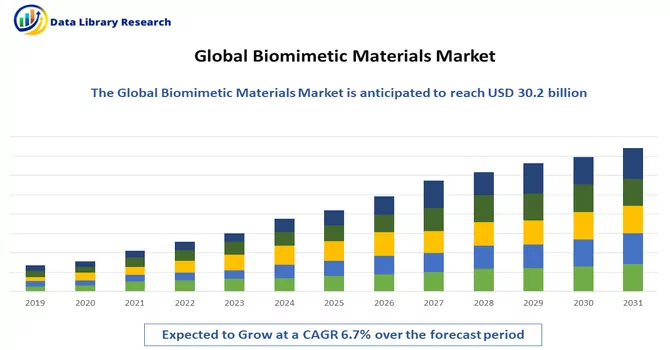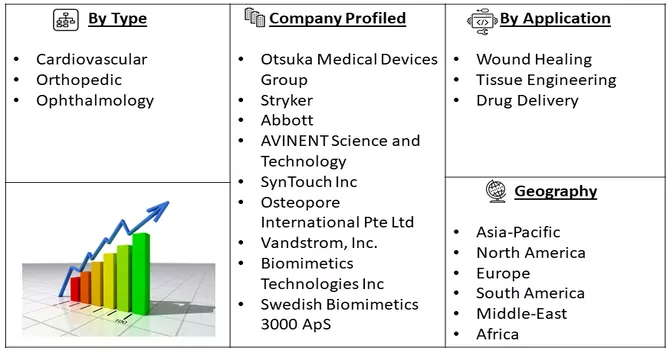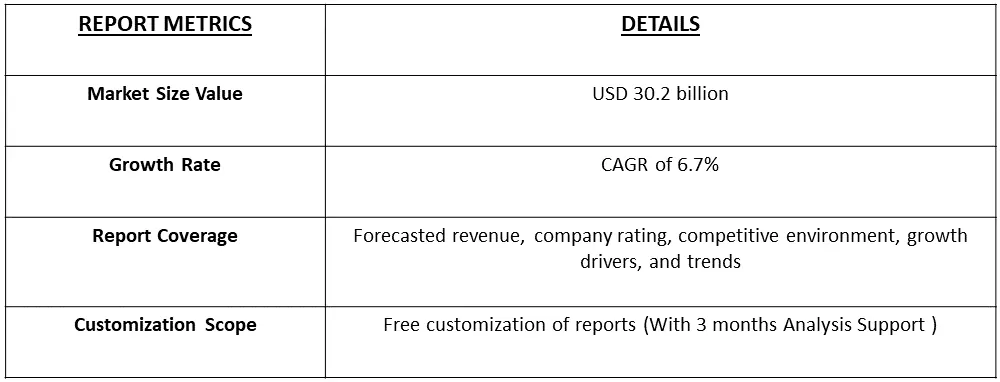The global medical biomimetics market size was valued at USD 30.2 billion in 2023 and is expected to expand at a compound annual growth rate (CAGR) of 6.7% from 2024 to 2031.

Get Complete Analysis Of The Report - Download Free Sample PDF
Biomimetics, also known as biomimicry, is an interdisciplinary field that involves the imitation, emulation, or abstraction of principles, structures, processes, and functions found in nature to solve human problems, design innovative technologies, and create sustainable solutions. Drawing inspiration from the biological world, biomimetics encompasses various scientific disciplines, including biology, chemistry, and engineering. Researchers and designers in biomimetics study and replicate natural systems, such as the structure of plants, the behavior of animals, or the processes within living organisms, to develop new materials, technologies, and systems that mimic or adapt these natural patterns. This approach aims to harness the efficiency, adaptability, and sustainability observed in biological systems to address challenges in diverse fields, including medicine, robotics, materials science, and architecture.
Biomimetics represents a multidisciplinary field that integrates principles from biology, chemistry, and engineering to synthesize materials, machines, or synthetic systems emulating biological processes. In the realm of pharmaceutics and medicine, biomimetic-based designs offer innovative solutions applicable to drug delivery, tissue engineering, and regenerative medicine. Leveraging biomimetics to address challenges in healthcare, particularly in the treatment of severe diseases such as cancer, holds significant promise. The rapid expansion of the medical biomimetics market is primarily propelled by increased government funding for biomimetics research, coupled with the widespread adoption and advancements in medical engineering and nanotechnology within the healthcare sector. This convergence of scientific disciplines not only fosters groundbreaking solutions but also underscores the potential for transformative breakthroughs in addressing complex medical challenges.
Market Segmentation: The Medical Biomimetics Market is Segmented By Type (Cardiovascular, Orthopedic, and Ophthalmology), Application (Wound Healing, Tissue Engineering, Drug Delivery), and Geography (North America, Europe, Asia-Pacific, Middle East & Africa, and South America). The report offers the value (in USD million) for the above segments.

For Detailed Market Segmentation - Download Free Sample PDF
The global medical biomimetics market is witnessing notable trends that are shaping the industry's trajectory. One significant trend is the increasing integration of biomimetic principles in medical device design and development. Biomimetics is being extensively applied in the creation of innovative medical implants, prosthetics, and other devices, enhancing their functionality and compatibility with the human body. Another emerging trend is the focus on bio-inspired drug delivery systems, where biomimetic approaches are employed to design drug carriers that mimic natural biological processes for targeted and efficient drug delivery. Furthermore, there is a growing trend towards utilizing biomimetics in tissue engineering and regenerative medicine, enabling the development of bioengineered tissues and organs that closely resemble natural counterparts. The market is also witnessing advancements in nanotechnology and materials science, facilitating the creation of biomimetic materials with enhanced biocompatibility and performance. Additionally, the rise in collaborative efforts between academic institutions, research organizations, and industry players is fostering cross-disciplinary innovation in the field of medical biomimetics. These trends collectively reflect a dynamic landscape where biomimetic solutions are increasingly gaining prominence across various medical applications.
Market Drivers:
Expansion of Technologies in the Healthcare Sector
The expansion of technologies in the healthcare sector has paved the way for groundbreaking innovations, with medical biomimetic materials emerging as a forefront contributor to this transformative landscape. These materials, inspired by biological systems and processes, are increasingly integrated into various healthcare applications, marking a paradigm shift in medical advancements. In areas such as tissue engineering, medical biomimetic materials are utilized to create scaffolds that mimic the extracellular matrix, promoting cell growth and regeneration. Additionally, in the development of medical devices, biomimetic materials play a crucial role in enhancing biocompatibility and improving the overall performance of implants, prosthetics, and other medical apparatus. The integration of these materials in drug delivery systems further revolutionizes therapeutic approaches, allowing for precise and targeted delivery inspired by natural biological processes. As technologies continue to evolve, the synergy between technological expansion and the use of medical biomimetic materials holds immense potential to revolutionize patient care, treatment outcomes, and the overall trajectory of healthcare innovation.
Rapid Growth of Artificial Intelligence and Automation
The rapid growth of artificial intelligence (AI) and automation is reshaping the landscape of healthcare, and when combined with medical biomimetic materials, it presents a powerful force driving transformative changes in medical practices. AI and automation are increasingly applied in medical diagnostics, personalized treatment plans, and predictive analytics, streamlining processes and improving patient outcomes. When integrated with medical biomimetic materials, these technologies enable the development of highly sophisticated and tailored medical solutions. AI algorithms can analyze vast datasets to inform the design of biomimetic materials, optimizing their properties for enhanced biocompatibility, durability, and functionality. Automation facilitates the efficient production of these materials, ensuring precision and consistency. In areas like regenerative medicine and tissue engineering, the convergence of AI, automation, and medical biomimetic materials holds the potential to revolutionize organ and tissue transplantation, offering personalized and biologically-inspired solutions. As these technologies advance, their synergy is poised to drive innovation, improve treatment efficacy, and contribute to the evolution of patient-centric healthcare practices.
Restraints:
Hight Cost of Materials
The high cost of biomimetic materials stands as a potential impediment to the growth of the medical biomimetic materials market. While these materials offer innovative solutions inspired by natural biological processes, their sophisticated design, intricate manufacturing processes, and the use of advanced technologies contribute to elevated production costs. The intricate nature of biomimetic materials often involves precision engineering and the utilization of high-quality components, further adding to the overall expenses. In the healthcare sector, where biomimetic materials play a pivotal role in areas such as tissue engineering and medical device development, the cost factor can limit their widespread adoption and accessibility. The healthcare industry faces the challenge of balancing the promising benefits of biomimetic materials with the economic considerations associated with their production. To overcome this barrier, ongoing efforts are essential to optimize manufacturing processes, explore cost-effective alternatives, and promote research and development aimed at making biomimetic materials more economically viable. Addressing the high cost challenge is crucial for unlocking the full potential of medical biomimetic materials and ensuring their broader integration into healthcare practices.
Generally, the COVID-19 pandemic has had widespread effects on various industries, including materials science and biotechnology. Disruptions in supply chains, changes in consumer behavior, and economic challenges have influenced markets globally. In the context of biomimetic materials, which often involve complex manufacturing processes and high-tech applications, the pandemic may have impacted research, development, and production activities. During crises like the COVID-19 pandemic, the prioritization of resources towards addressing immediate healthcare needs and the economic fallout can sometimes slow down advancements in certain sectors. However, the pandemic has also highlighted the importance of innovative materials and technologies in addressing healthcare challenges, potentially driving further interest and investment in biomimetic materials for medical applications.
Segmental Analysis:
Cardiovascular Segment is Expected to Witness Significant Growth Over the Forecast Period
Medical biomimetic materials are making significant strides in cardiovascular applications, offering innovative solutions to address challenges in cardiovascular medicine. These biomimetic materials, inspired by natural biological systems, enhance the development of cardiovascular implants such as stents, grafts, and heart valves. The use of biomimetic materials in heart valves aims to improve durability and reduce complications, mimicking the dynamic behavior and mechanical properties of native valves. In vascular grafts, biomimetic materials contribute to the design of grafts that closely emulate the extracellular matrix, promoting integration with the host tissue and reducing the risk of thrombosis and graft failure. Additionally, biomimetic materials play a crucial role in tissue engineering for myocardial regeneration, providing scaffolds that mimic the microenvironment of cardiac tissue and support the growth and differentiation of cells. While promising, challenges such as cost and long-term performance must be addressed for broader clinical adoption, driving ongoing research and advancements in materials science and cardiovascular medicine.
Tissue Engineering Segment is Expected to Witness Significant Growth Over the Forecast Period
Tissue engineering, a cutting-edge field at the intersection of biology and materials science, has catalyzed significant developments in the medical biomimetic material market. Biomimetic materials, inspired by natural biological systems, play a pivotal role in tissue engineering applications, offering solutions for regenerative medicine and the creation of functional biological substitutes. These materials are designed to closely mimic the extracellular matrix, providing a supportive environment for cell growth, differentiation, and tissue regeneration. In the medical biomimetic material market, tissue engineering applications span diverse areas such as bone regeneration, skin grafts, and the development of artificial organs. The use of biomimetic materials in tissue engineering enhances biocompatibility, reduces the risk of rejection, and supports the creation of functional tissues. This synergy between tissue engineering and medical biomimetic materials underscores their collective impact on regenerative medicine, heralding a new era in personalized healthcare solutions. The market for these biomimetic materials in tissue engineering is poised for growth as ongoing research and technological advancements continue to expand the possibilities for therapeutic interventions and organ replacement strategies.
North America Region Segment is Expected to Witness Significant Growth Over the Forecast Period
North America plays a pivotal role in the global medical biomimetic material market, contributing significantly to advancements in healthcare and biomedical applications. The region's well-established healthcare infrastructure, robust research and development capabilities, and a high level of technological innovation make it a key player in driving the adoption of biomimetic materials. In the medical field, biomimetic materials find applications in areas such as tissue engineering, regenerative medicine, and medical device manufacturing. The presence of leading pharmaceutical and biotechnology companies, academic institutions, and research centers in North America fosters collaborative efforts and accelerates the development of biomimetic solutions for diverse medical applications. Additionally, a strong regulatory framework and increasing awareness of the potential benefits of biomimetic materials contribute to their growing integration into clinical practices. The market for medical biomimetic materials in North America is characterized by continuous research endeavors, strategic collaborations, and the commercialization of innovative products, reflecting the region's commitment to advancing healthcare technologies and improving patient outcomes.

Get Complete Analysis Of The Report - Download Free Sample PDF
Major market players actively pursue strategies such as expanding their production capabilities, engaging in mergers and acquisitions, and conducting research and development initiatives to maintain a competitive edge in the industry. This involves increasing their capacity for manufacturing, acquiring other companies or merging with them to strengthen their market position, and investing in innovative research and development efforts. These strategic moves are crucial for staying ahead of competitors, enhancing market share, and ensuring sustained growth in the dynamic business environment. The commitment to these initiatives underscores the players' proactive approach in adapting to market trends, meeting evolving customer demands, and securing a prominent position in the competitive landscape. Key market players include:
Recent Developments:
1) In November 2021, Otsuka Medical Devices Co., Ltd. introduced the BioMimics 3D Vascular Stent System, a groundbreaking product designed to address acute blockages resulting from unsuccessful prior treatments in patients.
2) In February 2022, NanoHive Medical, LLC, a pioneer in advancing 3D printed, biomimetic spinal interbody fusion solutions, disclosed a distribution partnership with Accelus. This collaboration aims to enhance the distribution network for NanoHive Medical's Hive Soft Titanium series of interbody fusion devices within the United States.
Q1. What was the Biomimetic Materials Market size in 2023?
As per Data Library Research the global medical biomimetics market size was valued at USD 30.2 billion in 2023.
Q2. At what CAGR is the Biomimetic Materials market projected to grow within the forecast period?
Biomimetic Materials Market is expected to expand at a compound annual growth rate (CAGR) of 6.7% over the forecast period.
Q3. What are the factors driving the Biomimetic Materials market?
Key factors that are driving the growth include the Expansion of Technologies in the Healthcare Sector and Rapid Growth of Artificial Intelligence and Automation.
Q4. Who are the key players in Biomimetic Materials market?
Some key players operating in the market include
Data Library Research are conducted by industry experts who offer insight on industry structure, market segmentations technology assessment and competitive landscape (CL), and penetration, as well as on emerging trends. Their analysis is based on primary interviews (~ 80%) and secondary research (~ 20%) as well as years of professional expertise in their respective industries. Adding to this, by analysing historical trends and current market positions, our analysts predict where the market will be headed for the next five years. Furthermore, the varying trends of segment & categories geographically presented are also studied and the estimated based on the primary & secondary research.
In this particular report from the supply side Data Library Research has conducted primary surveys (interviews) with the key level executives (VP, CEO’s, Marketing Director, Business Development Manager and SOFT) of the companies that active & prominent as well as the midsized organization
FIGURE 1: DLR RESEARH PROCESS

Extensive primary research was conducted to gain a deeper insight of the market and industry performance. The analysis is based on both primary and secondary research as well as years of professional expertise in the respective industries.
In addition to analysing current and historical trends, our analysts predict where the market is headed over the next five years.
It varies by segment for these categories geographically presented in the list of market tables. Speaking about this particular report we have conducted primary surveys (interviews) with the key level executives (VP, CEO’s, Marketing Director, Business Development Manager and many more) of the major players active in the market.
Secondary ResearchSecondary research was mainly used to collect and identify information useful for the extensive, technical, market-oriented, and Friend’s study of the Global Extra Neutral Alcohol. It was also used to obtain key information about major players, market classification and segmentation according to the industry trends, geographical markets, and developments related to the market and technology perspectives. For this study, analysts have gathered information from various credible sources, such as annual reports, sec filings, journals, white papers, SOFT presentations, and company web sites.
Market Size EstimationBoth, top-down and bottom-up approaches were used to estimate and validate the size of the Global market and to estimate the size of various other dependent submarkets in the overall Extra Neutral Alcohol. The key players in the market were identified through secondary research and their market contributions in the respective geographies were determined through primary and secondary research.
Forecast Model
